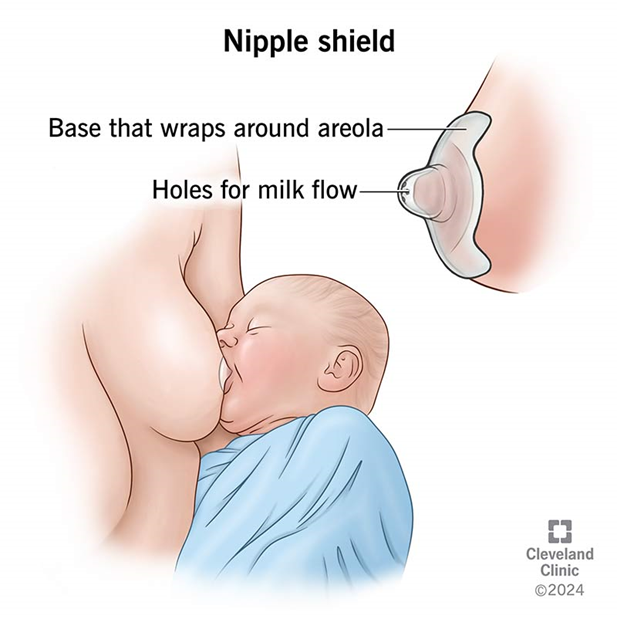A client who is one day postpartum reports to the nurse that her baby cannot latch onto the breast. The nurse observes that the client's nipples are inverted. Which action should the nurse implement?
Offer supplemental formula feedings.
Teach about the use of a breast pump.
Recommend using a breast shield.
Encourage the use of ice on the areola.
The Correct Answer is C
Choice A reason: Offering supplemental formula feedings is not the first-line action for inverted nipples as it does not address the issue and may lead to nipple confusion, potentially complicating future breastfeeding attempts.
Choice B reason: Teaching about the use of a breast pump is beneficial for milk expression but does not directly assist with the immediate concern of latching issues due to inverted nipples.
Choice C reason: Using a breast shield can be helpful for mothers with inverted nipples. It can temporarily draw out the nipple, allowing the baby to latch on more easily. This tool acts as a bridge between the breast and the baby's mouth, facilitating breastfeeding while the mother works on long-term solutions for her inverted nipples.
Choice D reason: Encouraging the use of ice on the areola may temporarily stiffen the nipple, but it is not a recommended practice for addressing inverted nipples as it can cause discomfort and may not be effective in promoting a successful latch.

Nursing Test Bank
Naxlex Comprehensive Predictor Exams
Related Questions
Correct Answer is A
Explanation
Choice A reason: Before administering IV fluids containing potassium chloride, it is crucial to ensure that the client has adequate urinary output, typically between 30 to 60 mL/hr. This indicates good kidney function, which is necessary for the excretion of potassium to prevent hyperkalemia, a potentially life-threatening condition.
Choice B reason: While magnesium levels can affect potassium levels, they are not the most critical assessment before potassium infusion. However, it is important to monitor magnesium levels as part of the overall electrolyte balance, especially in diabetic ketoacidosis.
Choice C reason: The size of the IV catheter is important for administration purposes, but it is not the most critical assessment data before starting potassium infusion. The catheter size affects the flow rate and comfort during infusion but does not impact the decision to start the infusion.
Choice D reason: Serum glucose level is a vital parameter to monitor in diabetic ketoacidosis, but it is not the most critical assessment before starting potassium infusion. The primary concern with potassium infusion is kidney function, as assessed by urinary output.
Correct Answer is ["0.3"]
Explanation
Step 1: Convert the client's weight from lbs to kg using the conversion factor you provided (1 kg = 2.2 lbs).
So, 110 lbs × (1 kg ÷ 2.2 lbs) = 50 kg
Step 2: Calculate the daily dosage of dalteparin in units using the prescription (150 units/kg).
So, 50 kg × 150 units/kg = 7500 units
Step 3: Determine how many mL of the medication this dosage corresponds to using the information on the syringe (7500 units/0.3 mL).
So, 7500 units × (0.3 mL ÷ 7500 units) = 0.3 mL
The nurse should administer 0.3 mL of dalteparin to the client.
Whether you are a student looking to ace your exams or a practicing nurse seeking to enhance your expertise , our nursing education contents will empower you with the confidence and competence to make a difference in the lives of patients and become a respected leader in the healthcare field.
Visit Naxlex, invest in your future and unlock endless possibilities with our unparalleled nursing education contents today
Report Wrong Answer on the Current Question
Do you disagree with the answer? If yes, what is your expected answer? Explain.
Kindly be descriptive with the issue you are facing.
